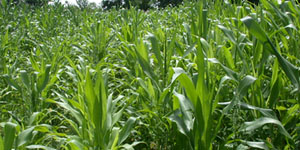Made in the Shade
When environmental conditions are poor, plants can’t get up and walk away. They must, instead, figure out how to deal with the stresses placed upon them by lack of sunlight or extreme temperatures, for instance.
Now scientists have discovered a genetic link to understanding how plants change their shape to respond to environmental challenges. Their finding could help plant breeders improve a variety of crops.

In the case of maize, or corn, plants respond to lack of sunlight, or shade, by concentrating on growing taller and not wider. That includes suppressing so-called “tillers,” or branches that start at the base of the corn plant. Instead, the plant focuses its energy on producing one or two really good, healthy ears of corn on a central stalk rather than numerous, smaller – and less tasty – ears on widening branches.
This makes a lot of sense, if you’ve ever been near a cornfield. Stalks stand shoulder to shoulder like soldiers, vying to be the tallest in order to take full advantage of the sun’s energy. Branches or buds grown near the ground have no chance of getting many, if any, of the sun’s rays.
In research published online in Proceedings of the National Academy of Sciences, NC State post-doctoral genetics researcher Allison Weber joined colleagues from Cold Spring Harbor Laboratory and the University of Wisconsin-Madison to show that a certain gene, grassy tillers1 (gt1), is involved in changing maize plant shape in the absence of sun.
The scientists isolated a mutated version of the gene – which instead of suppressing tillers, allowed them to grow – and compared test plants to normal maize plants. They showed that gt1 partners with another shade avoidance gene called tb1 to influence the plant’s shape.
The scientists say that understanding gt1’s function could help improve crops. Keeping gt1 turned on lets plants like maize grow straight and tall in the shade, but some plants may need to “branch out” and grow wide. So inhibiting gt1 could be advantageous for greater yields of switchgrass, for example, a promising candidate for biofuel production.
- Categories:


